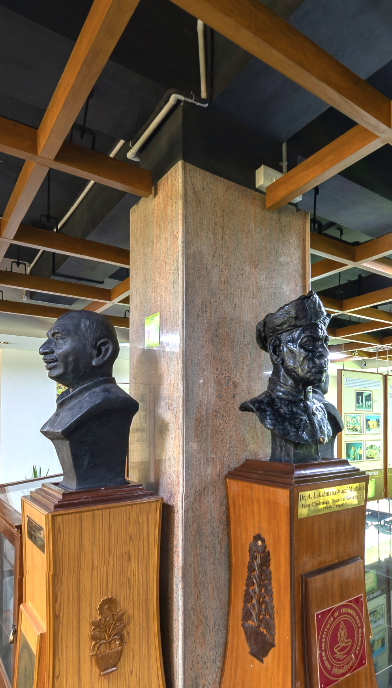Prof. S. Sampath addresses the audience during the Computer Centre inauguration, 1973
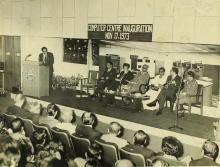
- Photographs , Administrators, Faculty, Inaugurations , 1970s
The inauguration took place on 17 November. IIT Madras had recently acquired the IBM 370/155 computer with the help of West Germany. There is a report of the event in the book ‘Computer Education in India: Past, Present and Future’, where it is mentioned that Prof. Sampath “stressed the need to convince trade union leaders that the use of computers would in the long run result in greater employment.” In the same book, Prof. Sampath’s article notes, “The establishment of the computer centre is the realization of a cherished dream.” IBM made a large mural specifically for the occasion, using…
Prof. H. N. Mahabala addressing the audience, 1973
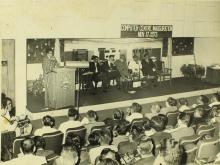
- Photographs , Administrators, Faculty, Inaugurations , 1970s
This photograph was taken during the Inauguration of the Computer Centre, which saw the start of a new era in computing at IIT Madras. The IBM 370 was installed at the Institute and it was ready to be put into use. In a report published in the book ‘Computer Education in India: Past, Present and Future’, Prof. Mahabala, who was the first Professor-in-charge of the Computer Centre of IIT Madras, mentions, “With this, IIT is now among the few institutions in the world to have been equipped with a versatile computer system.” He goes on to share some of the key features of the IBM 370,…
The IBM 2741 communication terminal at the inauguration of the Computer Centre, 1973

- Photographs , Administrators, Faculty, Inaugurations , 1970s
The IBM 2741 was a printing communication terminal, inspired by the IBM Selectric typewriter. According to Wikipedia, it offered up to 50% higher speed compared to the teletypewriter machines which were used as printing terminals at the time. It also offered top quality printing, interchangeable type fonts and also upper and lower case letters. It also operated without much noise. A news report in The New Indian Express provides details about parts of the 370 computer system. According to the report, there were three typewriter terminals at IIT Madras that could type 15.5 characters per…
A section of the audience at the inauguration of the Computer Centre, 1973
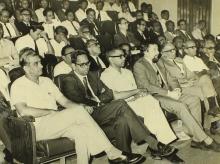
- Photographs , Faculty, Inaugurations , 1970s
First row, from left, Prof. R. G. Narayanamurthi (Department of Mechanical Engineering), Prof. S. K. Srinivasan (Department of Mathematics, second from left), Prof. J. C. Kuriacose (Department of Chemistry, third from left), Prof. R. K. Gupta (Department of Humanities and Social Sciences, fifth from left) and Prof. Venkata Rao (Department of Electrical Engineering, seventh from left). Second row, from left Prof. B. Ramaswami (Electrical Engineering Department, second from left), and Prof. M. C. Gupta (Mechanical Engineering Department, sixth from left). Third row from left, Prof.…
Taking a look at the IBM 3215 console terminal and printer, 1973
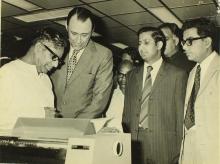
- Photographs , Inaugurations, Visiting VIPs , 1970s
The device was used to control the operations of the Main Frame (IBM 370/155). Once started, messages were printed on the fan fold pack (a sheet of paper) which would indicate the status of the system. It could print at a speed of 85 characters per second according to a report in The New Indian Express. Computer Operators were trained to work with the device in scheduling programs submitted on punched cards. They were also trained to attend to various devices such as the printer, tape drive and disk packs. Mr. C. Subramaniam (extreme left) was the Union Minister for Industrial Development…
Dr. Erhard Eppler and Mr. C. Subramaniam during the Computer Centre inauguration, 1973
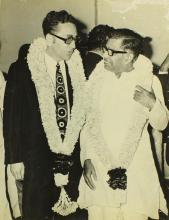
- Photographs , Inaugurations, Visiting VIPs , 1970s
The Computer Centre was inaugurated on 17 November. It was located in the Building Science Block (BSB) at the time, and the IBM 370 occupied most of the first floor of the BSB throughout the 1970s and 1980s. Dr. Eppler was the Minister for Economic Co-operation for the Federal Republic of Germany while Mr. Subramaniam was the Union Minister for Industrial Development and Science and Technology. Mr. Subramaniam had previously visited IIT Madras in 1961, when he came as chief guest to the Second Institute Day.
Distinguished guests Mr. C. Subramaniam (left) and Dr. Erhard Eppler (right) during the inauguration of the Computer Centre, 1973
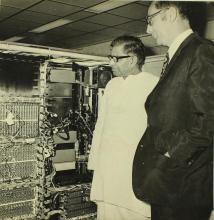
- Photographs , Inaugurations, Visiting VIPs , 1970s
The IBM 370/155 system was acquired by IIT Madras in this year. It occupied most of the first floor of the Building Sciences Block in the 1970s and 1980s. Prior to this, IIT Madras did not have a powerful, centralized computing facility and research scholars from the Institute had to rely on the IBM 360 at IISc Bangalore to do their project work. The installation of the IBM 370 meant that IITians would no longer have to depend on any other Institute to conduct research work and to compute. The IBM 370 was used by students of IIT Madras. Students would use the system for academic work…
Dr. Erhard Eppler presents a Special Brochure to Mr. C. Subramaniam at the Computer Centre inauguration, 1973
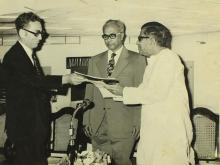
- Photographs , Administrators, Inaugurations, Visiting VIPs , 1970s
This photograph was taken during the inauguration of the Computer Centre in 1973. The venue can be determined by the mural, which is partly visible behind the chairs. IBM had printed a large mural of the Computer Centre at IIT Madras with the newly installed IBM 370 computer system on Prof. Mahabala’s request. It was placed behind the stage during the inauguration. In his speech at the inauguration, Prof. K. A. V. Pandalai (Director) revealed that a “Special Brochure” about the computer system was released by Dr. Eppler. The brochure contained facts about the IBM 370 and also the…
The IBM 2741 communication terminal at the inauguration of the Computer Centre, 1973
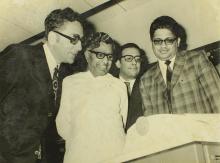
- Photographs , Administrators, Faculty, Inaugurations , 1970s
The IBM 2741 was a printing communication terminal, inspired by the IBM Selectric typewriter. According to Wikipedia, it offered up to 50% higher speed compared to the teletypewriter machines which were used as printing terminals at the time. It also offered top quality printing, interchangeable type fonts and also upper and lower case letters. It also operated without much noise. A news report in The New Indian Express provides details about parts of the 370 computer system. According to the report, there were three typewriter terminals at IIT Madras that could type 15.5 characters per…
Taking a look at the IBM 3215 console terminal and printer, 1973
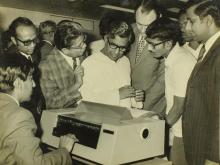
- Photographs , Faculty, Inaugurations, Visiting VIPs , 1970s
This device was used to control the operations of the Main Frame (IBM 370/155). When the machine was started, messages were printed on the sheet of paper (known as the fan fold pack). These messages would indicate the status of the system. It could print at a speed of 85 characters per second according to a report in The New Indian Express. The IBM 370 followed a batch system where programs were submitted in punched cards. Computer Operators were trained to work with the device in scheduling the programs submitted on punched cards. They were also trained to attend to the devices such as…
The IBM 2741 communication terminal at the inauguration of the Computer Centre, 1973
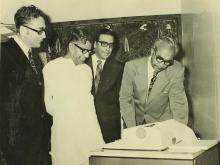
- Photographs , Administrators, Inaugurations, Visiting VIPs , 1970s
The IBM 2741 was a printing communication terminal, inspired by the IBM Selectric typewriter. According to Wikipedia, it offered up to 50% higher speed compared to the teletypewriter machines which were used as printing terminals at the time. It also offered top quality printing, interchangeable type fonts and also upper and lower case letters. It also operated without much noise. A news report in The New Indian Express provides details about parts of the 370 computer system. According to the report, there were three typewriter terminals at IIT Madras that could type 15.5 characters per…
Mr. C. Subramaniam taking a look at the IBM 2741 communication terminal during the inauguration of the Computer Centre, 1973
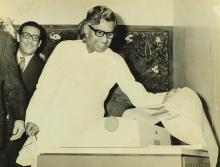
- Photographs , Administrators, Inaugurations, Visiting VIPs , 1970s
The IBM 2741 was a printing communication terminal, inspired by the IBM Selectric typewriter. According to Wikipedia, it offered up to 50% higher speed compared to the teletypewriter machines which were used as printing terminals at the time. It also offered top quality printing, interchangeable type fonts and also upper and lower case letters. It also operated without much noise. A news report in The New Indian Express provides details about parts of the 370 computer system. According to the report, there were three typewriter terminals at IIT Madras that could type 15.5 characters per…
Prof. K. A. V. Pandalai welcomes the gathering during the Computer Centre inauguration, 1973

- Photographs , Administrators, Inaugurations , 1970s
Prof. Pandalai had recently become Director on the first of October 1973 over a month prior to the inauguration of the Computer Centre. He was the Director who succeeded Prof. A. Ramachandran. In his speech at the inauguration, Prof. Pandalai expressed interest in IIT Madras becoming self-reliant after the German aid ended. According to a report in the book ‘Computer Education in India: Past, Present and Future’, “He appealed to faculty members to think in terms of promoting self reliance, keeping expectations from others to the minimum.” The Archive of IIT Madras has documented the original…
Mr. C. Subramaniam addresses the audience during the Computer Centre inauguration, 1973

- Photographs , Administrators, Faculty, Inaugurations , 1970s
The inauguration of the Computer Centre took place on 17 November. It was a turning point in the history of the Institute. The IBM 370/155 was officially a part of IIT Madras with the help of West Germany which was supplying technical support to IIT Madras under the Indo-German agreement. The IBM 370 allowed students and research scholars to do their projects with ease. In the book ‘Computer Education in India: Past, Present and Future’, it is reported that Mr. Subramaniam, in his speech said that the role of the computer should be looked at from a “broader and long term context of…
Prof. K. A. V. Pandalai addresses the audience during the inauguration of the Computer Centre in 1973
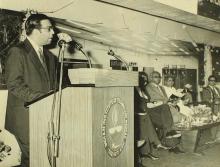
- Photographs , Administrators, Inaugurations, Visiting VIPs
Prof. Pandalai was the third Director of IIT Madras. He was Director from 1973 to 1977. He is known for having taught the former President of India Dr. A. P. J. Abdul Kalam at the Madras Institute of Technology. In the course of his career, Prof. Pandalai taught at Madras Institute of Technology, IIT Madras, Polytechnic Institute of Brooklyn, Stanford University, California, and George Washington University at Washington, USA. He guided M. Tech. / MS and Ph. D. students during his career and published around 100 research papers to his credit. IBM made a large mural specifically for the…
- Contribute
to the Centre -
Monetary
Support - Digital
Material

